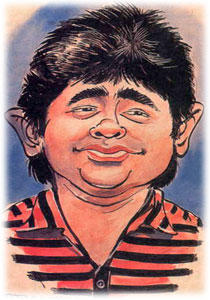| The engaging story of India’s embrace of English is glazed with wit and tongue-in-cheek humour, but lacks a nuanced quality. |
Entry From Backside Only: Hazaar Fundaas of Indian-English, Binoo K. John, Penguin India, p.224, Rs.95.

Apart from a few ill-fated attempts by Binoo John to “explain” humour that’s self-evident (rather like explaining a punch line), and pat himself on the back when there’s no reason to feel insecure, this entertaining swim through the story of Indian-English is a nice way to spend an afternoon with some chai-wai for company.
It is replete with gems mined from the colonial period, ranging from the ridiculous to the sublimely funny. Advertisements of quacks and legitimate sellers, letters to the editor and dialogues from cinema, all allow John to traverse a ‘literary’ landscape strewn with blunders in grammar, spelling, capitalisation, punctuation, malapropisms and inappropriate idioms. A smaller serving with crisper editing would have been just right. One is educated and frequently amused by this use, or rather, misuse of the language. However, the tone is never condescending. John’s sensibility comes from knowing that it isn’t easy to fathom the illogic of English. But today, colours, flavours, textures and sounds that imbue Indian languages with an onomatopoeic quality make Indian-English inimitable, robust and quirky — just the way we are! Advertising bears this out. From gullies to highways, roadside shops to mega malls, it flaunts itself. This mongrel child or hybrid language has been adopted by Booker Prize winners and celebrated in everyday communication too.
Sociology of languageHow did it all happen? The author tells us what we know; that we were saddled with English, thanks to Macaulay’s insidious plans to create “…interpreters …and Indians in blood and colour but English in taste, in opinion, in words and in intellect”. But insightfully notes that Indians “yearned” to take to all things British, including English, for reasons of credibility and upward mobility. He looks at the phenomenal growth of English teaching institutes and the rapidly selling Rapidex, to explore how and why English continues to be a vehicle to fulfil aspirations.
Since we speak more than 30-odd languages, it’s surprising that John hasn’t ploughed a bit deeper into the reasons behind why we speak and write the way we do or how we grapple with the habit of thinking in our mother tongue while expressing ourselves in English. Something he could do in a reprint! What he needs to get rid of then would be the typos. The editors have let Seshagiri go as Seshagir and classics as classis (pp. 140, 156).
Absorbing sectionIn an absorbing last quarter, the book looks at how the tables turned, how all things Indian fascinated the British! Glossaries such as Hanklyn-Janklyn and Hobson-Jobson compiled Indian-English words and expressions. Then came ingenious wordsmiths such as Desani, Rushdie and Arundhati Roy at a time when English was becoming inadequate to capture the Indian experience. They began to reshape and free English by taking all kinds of liberties and readers were in thrall — of their uninhibited use of language.
Fruitful John’s fundas are convincing enough to prove that this sub-genre, having imbibed socio-cultural trends, is now a confident linguistic entity, a stand-alone. As I was typing this piece, a rhythmic rendition in English, of “Welcome to the heart of incredible India”, a television ad-campaign, was playing. I had heard the Hindi version on a few occasions (“Hindustan ka dil dekho”). Brilliantly translated, it was pure Indian-English of the heartland kind, capturing the lilt and rhythm without losing any of the charm and impact of the original. We are playing with Macaulay’s bhasha and loving it!

No comments:
Post a Comment